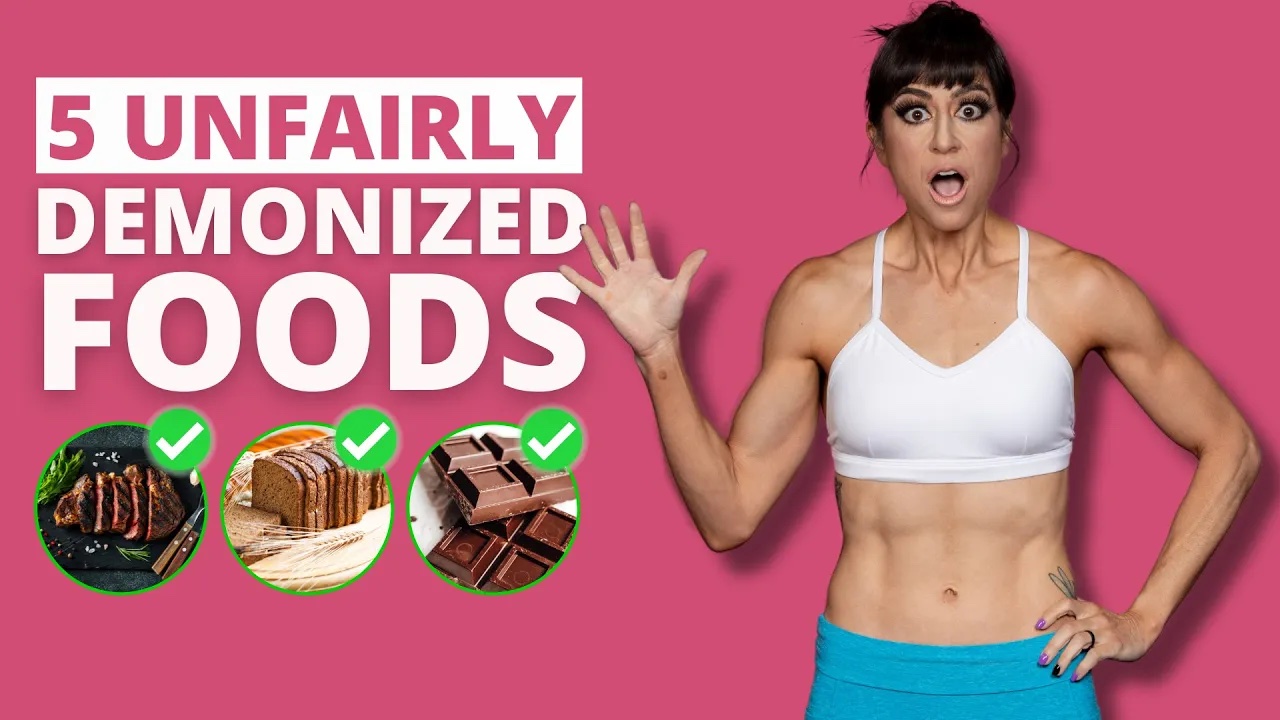
How to Actually Get Abs (10 Annoying Tips That Work!)
So you want to see more ab definition…
You want to achieve that elusive “six pack”…
Well, here are 10 annoying nutrition tips to help you get there!
But a word of warning to get abs, you can’t be concerned with sustainability.
That comes later.
This isn’t the time to focus on how you can work in your cocktails or your favorite desserts as much as I’m all about balance long-term.
Because what we do to achieve a goal, is NOT what we do to maintain it.
But to reach a level of leanness you’ve never achieved, or haven’t seen in awhile, you’ve got to be willing to sacrifice and push hard, especially when you’d rather sit on the coach and binge watch chick flicks while eating ice cream…
Maybe that’s just me…
But achieving abs is about pushing your body’s set point, and that does mean being more precise with your diet and workouts.
Those 1% matter.
That’s why these 10 tips are key.
And note, simple doesn’t mean easy.
Actually often the simpler something is, the harder it is long term and the more tempted we are to try to do more or chase a new fad diet or shiny object…
Don’t.
The biggest thing is CONSISTENCY with all of this past the point you want to quit…PERIOD.
Which is why Tip #1 is – Be boring.

Yup. Boring.
I love trying new restaurants, and have more favorite restaurants on doordash than I should probably admit while always looking for what’s new…
But if you’re focused on getting abs, especially for the first time, diversity is your enemy.
It can trigger cravings.
Make hitting your macros harder.
And it can make it tougher to know if something is or isn’t working.
The more you keep things basic, the easier the process will be.
Tip #2: Cut back on protein bars.
I don’t know about you, but I don’t like feeling hungry.
And you are going to be a bit hungry when first pushing to a new level of leanness.
That’s why cutting back on processed snacks like protein bars can be key. They are very calorically dense often for very few bites.
They often are not satisfying in the slightest and leave you feeling still hungry right after due to the lack of food volume.
So be conscious of how you use them and even try to include them with other high volume foods or only when on the go!
Tip #3: Stop the daily fluctuations.
If you want results to snowball faster, you’ve got to be willing to be more precise. That means hitting your macros within 2% and 50 calories plus or minus daily.
Not just in weekly averages where things fluctuate greatly day to day.
Not excusing a day “off plan”, which can often impact our macros more than we realize.
But every single day hitting those numbers consistently and precisely, even using the same meals and foods as I mentioned with tip 1.
That’s what adds up and allows us to know what is and isn’t working.
And if you’re thinking, “That isn’t sustainable.”
It’s not meant to be. What we do to reach a goal isn’t what we do to maintain it. And during maintenance a new balance has to evolve.
But to first get there, you’ve got to embrace the grind!
Tip #4: Focus on fiber.
Very rarely is gut health and fiber the first thing that comes to mind when you think about getting lean and losing fat.
But focusing on getting about 25-30 grams of fiber per day can really improve your fat loss results.
A healthy gut, and consuming enough fiber, reduces inflammation and cravings and improves insulin sensitivity and satiety.
It keeps your metabolic rate higher and even reduces the rate of protein breakdown to help you preserve your muscle mass as you lean down.
So take care of your gut with fiber to balance your appetite and make the fat loss process easier!
Tip #5: Get 30-40 grams of protein per meal.
Yup. The tip all too many of us know and resist…increasing our protein!
But not just increasing our overall daily totals, specifically focusing on that 30-40 gram range for a meal or more.
While many have heard the myth you won’t utilize more in one sitting, studies have shown you will utilize up to 100 grams efficiently.
And that 30-40 gram range is a great way to create an anabolic response even as we get older and we aren’t able to utilize protein as efficiently.
That amount helps make sure you’re fueling your lean muscle while also accounting for the fact that protein is used for so much else in our body.
Being in a deficit, you are deficient and depleted. Getting enough protein ensures you aren’t catabolizing your muscle mass to get the amino acids you need for repair or other bodily processes.
Not to mention, you burn more calories even at rest to digest protein making it something you can eat more of without as much risk of gaining unwanted fat.
Tips #6: Prioritize carbs around your workout.
Carbs are immediate fuel.
To push hard in our workouts to get the biggest benefit, we need that energy source especially while in a deficit.
Timing more carbs pre-workout can help you have that readily available fuel while creating that anabolic environment to build muscle.
So no matter exactly your carb ratio, focus on getting some carbs for full glycogen stores prior to your training and then even refueling with carbs post workout to help you repair and rebuild.
Carbs are also protein sparing so help you really protect that lean muscle mass and use that protein more efficiently!
And do not fear if you train at night eating more carbs later in the day!
Tip #7: Take breaks.
While you may think, “It’s only a couple of pounds.” Those last few pounds are often the slowest to lose and the ones you have to be most strategic in losing.
Push too great a deficit and you risk losing even more muscle in the process.
But our body adapts to what we do.
It’s why the process isn’t linear and at times you have to step back from your cut and push to get lean and take that diet break.
This ultimately allows you to be consistent for longer and not burn out, not only mentally but physically.
It allows you to even add a bit of muscle and avoid metabolic adaptations along the way.
So if you’ve been pushing hard toward your goals for a few months, consider a 1-2 week phase of eating at maintenance as you push your training to build muscle and get that mental break from more intensive dieting.
Tip #8: Be careful of pre-workout or fat burners.
I know it’s tempting to want a quick fix or a boost, but these supplements can be dangerous and also have a further reaching impact on our recovery than we realize.
And our sleep is so essential to balancing our appetite and hormone levels for fat loss not to mention recovery from our workouts to maintain muscle.
While they may feel good to boost our energy and provide a temporary metabolic boost, they can impact our sleep and recovery in a negative way.
And unless we keep consuming more and more, we won’t keep seeing the same boost from them.
So if you’re finding you want to jump to using these things, assess your meal timing and first consider just something simple like a cup of tea or coffee before you train if you need. But less is more and you can’t out supplement your workouts or macros!
Tip #9: Don’t set it and forget it!
Your body is adapting and changing through your journey to get abs. Your lifestyle and stress and priorities are also shifting.
That means you can’t just set your macros or diet habits and then go on autopilot.
While we don’t want to be changing things up every other second, we do need to watch progress and adjust as we go.
That may mean a diet break. It may mean a change in types of foods. It may even mean shifting macro breakdowns, cycling up and down in protein or even changing carbs and fat levels based on shifts in our activity.
But track and monitor your progress to adjust as you go and not feel like something should work forever in one form. Because it won’t!
Tip #10: Suck It Up Buttercup.
To reach any big, lofty goal, you’re going to have times you don’t want to do what you should.
Times things stink.
They don’t feel sustainable.
You don’t enjoy them.
At these times, you need to tell yourself to suck it up and keep going. That’s the only way for you to push through.
And when it feels like nothing is happening, that’s often where we usually quit and where we need to keep going instead. Because often that is right before we break through and really see results begin to pop.
So if you’ve even felt like you’ve looked worse recently while pushing hard, KEEP GOING! Realize the areas that have improved and celebrate your consistency and realize it is part of the process!
But focus on consistent changes that build past the point you want to quit.
And realize that precision is so important when we want to push boundaries. Embrace the hard and keep going!
Dial in your diet to match your workouts and build your leanest, strongest body ever with my Metabolic Shred…
–> LEARN MORE






